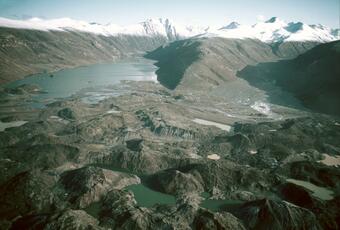Debris Avalanches Occur at Many Cascade Volcanoes
Massive slope collapse is natural part of the life cycle of Cascade volcanoes.
Massive slope collapse is natural part of the life cycle of Cascade volcanoes.

Volcanoes are naturally weak structures and at times are subject to slope collapses that range in size from small rock falls to very large landslides or debris avalanches. These catastrophic collapses of a volcano's slopes happen most often during volcanic activity but sometimes occur in non-eruption times, and they often transform into lahars that threaten populated regions downstream. They can be triggered by eruption, earthquake, or by long-term exposure to weathering of the rocks that make up the volcano. The 500-year old Electron Mudflow and the 5,600-year old Osceola Mudflow on Mount Rainier originated in areas of the volcano that had been structurally weakened by long-term exposure to acidic groundwater. Such weakened zones are common at ice-mantled Cascade volcanoes, where abundant melt water infiltrates porous volcanic rocks.
One well-known debris avalanche happened at Mount St. Helens on May 18, 1980 when the entire north face (volume equivalent to 1 million Olympic swimming pools) of the volcano slid away and deposited a layer of hummocky terrain 600 feet thick in the upper North Fork Toutle River Valley. As the eruption roared in the background, the landslide deposit mobilized into a destructive lahar, which moved 100 km (60 mi) down valley destroying everything in its path. Scientists observed and studied this massive debris avalanche and its deposits in detail and thereafter have been able to spot evidence of older debris avalanches at many other Cascade volcanoes. Mount Baker, Mount Rainier, Mount Adams, Mount St. Helens, Mount Hood, and Mount Shasta have all been reshaped by debris avalanches. At Mount St. Helens and its earlier proto-cone, geologists have found evidence of three pre-1980 debris avalanches. Debris avalanches are a natural part of the life cycle of Cascade volcanoes.

To learn more about these large landslides and how they affect areas around volcanoes, visit the Volcano Hazards Program debris avalanche webpage.
Massive slope collapse is natural part of the life cycle of Cascade volcanoes.
Massive slope collapse is natural part of the life cycle of Cascade volcanoes.

Volcanoes are naturally weak structures and at times are subject to slope collapses that range in size from small rock falls to very large landslides or debris avalanches. These catastrophic collapses of a volcano's slopes happen most often during volcanic activity but sometimes occur in non-eruption times, and they often transform into lahars that threaten populated regions downstream. They can be triggered by eruption, earthquake, or by long-term exposure to weathering of the rocks that make up the volcano. The 500-year old Electron Mudflow and the 5,600-year old Osceola Mudflow on Mount Rainier originated in areas of the volcano that had been structurally weakened by long-term exposure to acidic groundwater. Such weakened zones are common at ice-mantled Cascade volcanoes, where abundant melt water infiltrates porous volcanic rocks.
One well-known debris avalanche happened at Mount St. Helens on May 18, 1980 when the entire north face (volume equivalent to 1 million Olympic swimming pools) of the volcano slid away and deposited a layer of hummocky terrain 600 feet thick in the upper North Fork Toutle River Valley. As the eruption roared in the background, the landslide deposit mobilized into a destructive lahar, which moved 100 km (60 mi) down valley destroying everything in its path. Scientists observed and studied this massive debris avalanche and its deposits in detail and thereafter have been able to spot evidence of older debris avalanches at many other Cascade volcanoes. Mount Baker, Mount Rainier, Mount Adams, Mount St. Helens, Mount Hood, and Mount Shasta have all been reshaped by debris avalanches. At Mount St. Helens and its earlier proto-cone, geologists have found evidence of three pre-1980 debris avalanches. Debris avalanches are a natural part of the life cycle of Cascade volcanoes.

To learn more about these large landslides and how they affect areas around volcanoes, visit the Volcano Hazards Program debris avalanche webpage.

